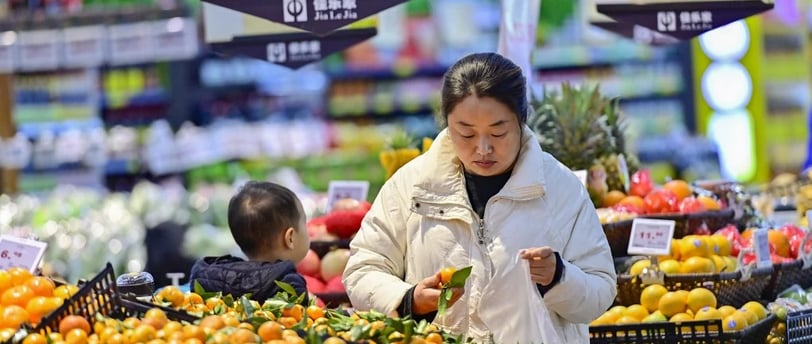Add your promotional text...
China's Inflation Conundrum: Why Stimulus Measures Are Falling Short of Reviving Consumer Confidence
Synopsis: China's inflation data for December paints a mixed picture. While producer price index (PPI) contraction shows signs of slowing, consumer price index (CPI) inflation remains weak, highlighting muted consumer spending despite aggressive government stimulus.
MARKETSGLOBAL
By Alankrita Shukla
1/9/20253 min read


The State of China's Inflation: A Balancing Act Between Stimulus and Stagnation
China's December inflation data reveals ongoing challenges in reviving economic growth, as both consumer and producer price indices reflect a sluggish recovery. Despite Beijing's aggressive stimulus measures in late 2024, consumer spending remained subdued, and factory activity continued to grapple with persistent deflationary pressures.
The figures illustrate the complexities of China's post-pandemic economic recovery and raise questions about the effectiveness of current policies in spurring sustainable growth.
Consumer Inflation Remains Tepid
According to official government data released on Thursday, the consumer price index (CPI) grew by just 0.1% year-on-year in December, aligning with market expectations. However, this was a decline from the 0.2% growth recorded in November, highlighting continued weakness in consumer spending. On a month-on-month basis, CPI remained unchanged, further underscoring the lack of momentum in household consumption.
This tepid inflation print suggests that consumers are exercising caution amidst uncertainties surrounding China's economic outlook. While business activity has shown some improvement, thanks to a slew of stimulus measures announced late last year, these efforts have failed to significantly boost consumer confidence or spending.
What CPI Tells Us About Consumer Behavior
The lackluster CPI growth is indicative of deeper structural issues:
Economic Uncertainty: Heightened caution among Chinese consumers has dampened their willingness to spend.
Limited Impact of Stimulus on Households: While businesses benefited from policy support, consumers appear unconvinced of long-term economic stability.
Sluggish Demand Recovery: Even during the holiday season, traditionally a time for increased spending, consumption remained subdued.
This stagnation in consumer spending underscores the challenges Beijing faces in creating a balanced recovery driven by both business and household demand.
Producer Inflation: Marginal Improvements Amid Persistent Challenges
On the business side, the producer price index (PPI) contracted by 2.3% year-on-year in December, marking the 27th consecutive month of deflation in factory gate prices. While this was a slight improvement from November's 2.5% contraction, it still reflects ongoing struggles in China's manufacturing sector.
Key factors driving the prolonged contraction in PPI include:
Sluggish Domestic Demand: Factories continue to grapple with insufficient local consumption.
Overcapacity: Excess production capacity has led to downward pressure on prices.
Muted Input Costs: Lower costs for raw materials and energy have further contributed to declining factory prices.
Despite some improvement, the data highlights the structural challenges facing China's industrial sector as it contends with weak demand and subdued pricing power.
The Stimulus Dilemma: Why Policies Are Falling Short
Beijing rolled out a series of stimulus measures in late 2024 aimed at jumpstarting economic activity. These included tax cuts, increased government spending, and policies to support businesses. While these measures have helped stabilize parts of the economy, their impact on consumer spending and factory output remains limited.
The disconnect between business and consumer responses to these policies reveals a critical challenge for China's policymakers:
Targeted Stimulus: Much of the support has been directed at businesses, leaving households less confident about their financial future.
Structural Challenges: Overcapacity in manufacturing and a lack of competitive innovation continue to weigh on the industrial sector.
Global Economic Pressures: Weak global demand and trade uncertainties further exacerbate domestic challenges.
The Road Ahead: What China Needs to Address
China's inflation data reflects a recovery that is uneven and fragile. To build a more robust and sustainable growth trajectory, Beijing may need to consider the following:
Strengthening Consumer Confidence: Policies should focus on boosting household incomes and reducing uncertainties to encourage spending.
Addressing Overcapacity: Structural reforms in key manufacturing sectors can help balance supply and demand.
Diversifying Economic Growth: Moving away from an over-reliance on exports and heavy industry toward services and technology could create more sustainable growth.
International Trade Relationships: Strengthening trade partnerships and resolving geopolitical tensions will be critical for supporting both domestic and export-driven growth.
In conclusion, China's December inflation data underscores the dual challenges of muted consumer spending and prolonged industrial deflation. While recent stimulus measures have shown some success in stabilizing business activity, they have yet to translate into significant gains in consumer confidence or household spending.
As Beijing grapples with these complex dynamics, the path forward requires targeted policies that address both structural and cyclical challenges. A balanced recovery, driven by robust demand from both consumers and businesses, will be essential for sustaining China's economic momentum in 2025 and beyond.
This nuanced recovery story not only highlights the intricacies of China's domestic economy but also serves as a critical indicator for global markets, which are closely watching the world's second-largest economy for signs of sustained growth.
